NCERT Solutions for Class 10 Maths Chapter 3 Pair of Linear Equations in Two Variables
CBSE Class 10th Exam Date:01 Jan' 26 - 14 Feb' 26
Solving a pair of linear equations is like finding where two friends agree to meet—on the same path, at the same point. A pair of linear equations in two variables consists of two equations in x and y, and solving the pair means finding the point where their graphs intersect on the Cartesian plane. NCERT Solutions for Class 10 Maths will provide clear, in-depth solutions that accurately answer all the exercise questions in the NCERT textbook. In this chapter, students will work with multiple methods for solving linear equations, including graphical, algebraic, substitution, and elimination methods. NCERT Solutions are trusted by teachers for building a strong foundation in concepts.
This Story also Contains
- NCERT Solutions for Class 10 Maths Chapter 3 Pair of Linear Equations in Two Variables: Download Free PDF
- NCERT Solutions for Class 10 Maths Chapter 3 Pair of Linear Equations in Two Variables: Exercise
- Pair of Linear Equations in Two Variables Class 10 NCERT Solutions: Exercise-wise
- NCERT Pair of Linear Equations in Two Variables Class 10 Solutions: Notes
- Pair of Linear Equations in Two Variables Class 10 Chapter 3: Topics
- Why are Class 10 Maths Chapter 3 Pair of Linear Equations in Two Variables Question Answers Important?
- NCERT Solutions for Class 10 Maths: Chapter Wise
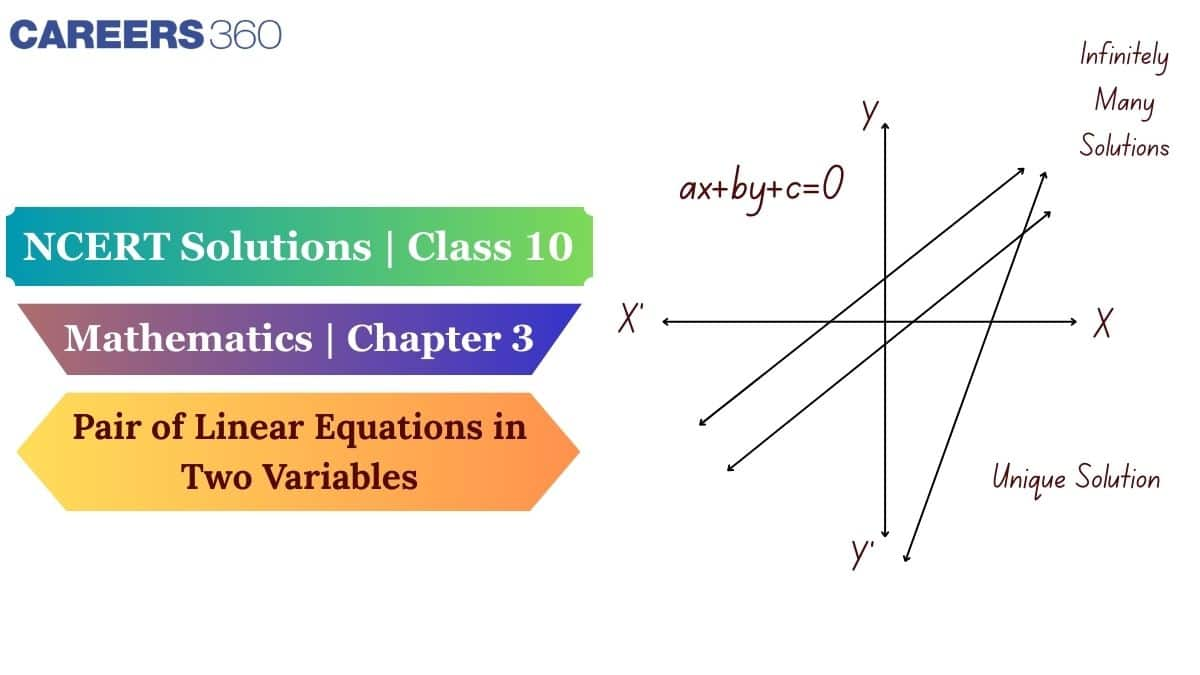
A pair of linear equations shows that every problem has a point where paths cross, if we solve it correctly. These equations play a key role in algebra, and their use can be seen in various mathematical and real-world applications. Our academic team here at Careers360 comprises experienced experts with years of teaching experience who have developed these NCERT Solutions for Class 10 content based on the modified NCERT Syllabus. For a detailed syllabus, study materials, and downloadable PDFs, check out the NCERT article.
NCERT Solutions for Class 10 Maths Chapter 3 Pair of Linear Equations in Two Variables: Download Free PDF
The NCERT Solutions for Class 10 Maths Chapter 3 have been prepared by Careers360 experts to make learning simpler and to help you score better in exams. A downloadable PDF has been provided — click on the link below to access it.
NCERT Solutions for Class 10 Maths Chapter 3 Pair of Linear Equations in Two Variables: Exercise
NCERT Class 10 Maths Chapter 3 Pair of Linear Equations in Two Variables question answers with detailed explanations are provided below.
|
Pair of Linear Equations in Two Variables Class 10 Question Answers |
Q1: Form the pair of linear equations in the following problems and find their solutions graphically.
Answer:
Let the number of boys be x and the number of girls be y.
Now, according to the question,
Total number of students in the class = 10, i.e.
$\Rightarrow x+y=10.....(1)$
And, given that the number of girls is 4 more than the number of boys, it means $x=y+4$
$\Rightarrow x-y=4..........(2)$
Different points (x, y) satisfying equation (1)
|
X |
5 |
6 |
4 |
|
Y |
5 |
4 |
6 |
Different points (x,y) satisfying equation (2)
|
X |
5 |
6 |
7 |
|
y |
1 |
2 |
3 |
Graph,
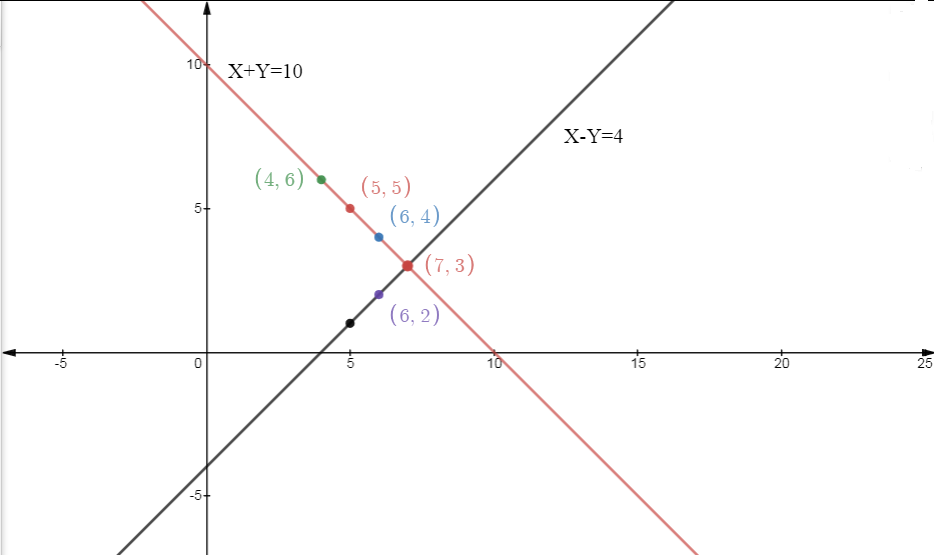
As we can see from the graph, both lines intersect at the point (7,3). that is x= 7 and y = 3, which means the number of boys in the class is 7 and the number of girls in the class is 3.
Q1: Form the pair of linear equations in the following problems and find their solutions graphically.
Answer:
Let the price of 1 pencil be x, and y be the price of 1 pen.
Now, according to the question
$5x+7y=50......(1)$
And
$7x+5y=46......(2)$
Now, the points (x,y) that satisfy the equation (1) are
|
X |
3 |
-4 |
10 |
|
Y |
5 |
10 |
0 |
And, the points (x,y) that satisfy the equation (2) are
|
X |
3 |
8 |
-2 |
|
Y |
5 |
-2 |
12 |
The Graph,
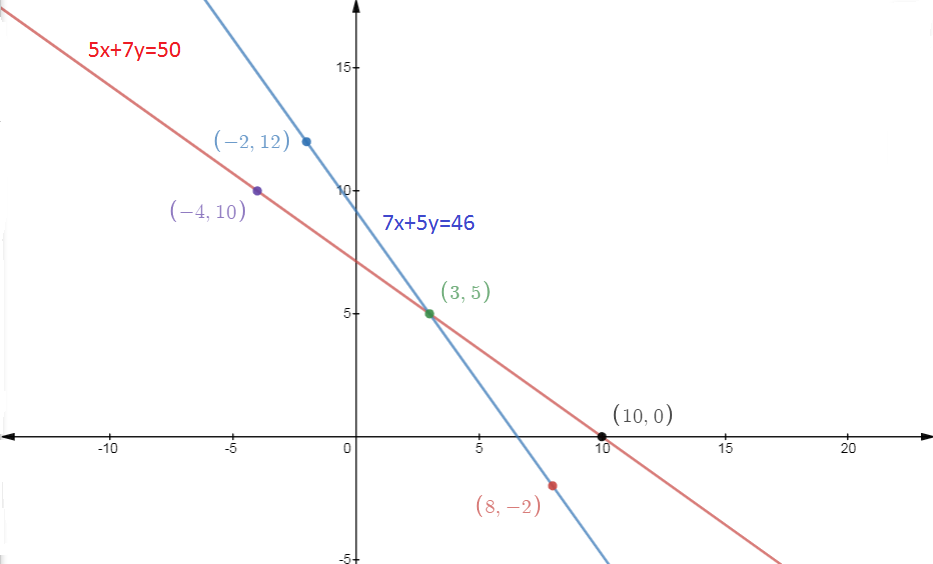
From the graph, both lines intersect at point (3,5), that is, x = 3 and y = 5, which means the cost of 1 pencil is 3 and the cost of 1 pen is 5.
Answer:
Given Equations,
$\\5x - 4y + 8 = 0 $and$ 7x + 6y - 9 = 0$
Comparing these equations with $a_1x+b_1y+c_1=0\:and\:a_2x+b_2y+c_2=0$ , we get
$\frac{a_1}{a_2}=\frac{5}{7},\:\frac{b_1}{b_2}=\frac{-4}{6}\:and\:\frac{c_1}{c_2}=\frac{8}{-9}$
It is observed that;
$\frac{a_1}{a_2}\neq\frac{b_1}{b_2}$
It means that both lines intersect at exactly one point and have a unique solution.
Answer:
Given Equations,
$\\9x + 3y + 12 = 0$ and $18x + 6y + 24 = 0$
Comparing these equations with $a_1x+b_1y+c_1=0\:and\:a_2x+b_2y+c_2=0$ , we get
$\\\frac{a_1}{a_2}=\frac{9}{18}=\frac{1}{2},\\\:\frac{b_1}{b_2}=\frac{3}{6}=\frac{1}{2}\: and \\\:\frac{c_1}{c_2}=\frac{12}{24}=\frac{1}{2}$
It is observed that;
$\frac{a_1}{a_2}=\frac{b_1}{b_2}=\frac{c_1}{c_2}$
It means that both lines are coincident and have infinitely many solutions.
Q2 (iii): On comparing the ratios $\frac{a_1}{a_2}$, $\frac{b_1}{b_2}$and $\frac{c_1}{c_2}$ , find out whether the lines representing the following pairs of linear equations intersect at a point, are parallel or coincident: (iii) $\\6x - 3y + 10 = 0; \\ 2x - y+ 9 = 0$
Answer:
Given Equations,
$\\6x - 3y + 10 = 0$ and $ 2x - y+ 9 = 0$
Comparing these equations with $a_1x+b_1y+c_1=0\:and\:a_2x+b_2y+c_2=0$ , we get
$\frac{a_1}{a_2}=\frac{6}{2}=3,\:\frac{b_1}{b_2}=\frac{-3}{-1}=3\:and\:\frac{c_1}{c_2}=\frac{10}{9}$
It is observed that;
$\frac{a_1}{a_2}=\frac{b_1}{b_2}\neq\frac{c_1}{c_2}$
It means that both lines are parallel and thus have no solution.
Answer:
Given Equations,
$\\3x + 2y = 5$ and $2x - 3y = 7$
Or, $3x + 2y - 5 = 0$ and $ 2x - 3y - 7 = 0$
Comparing these equations with $a_1x+b_1y+c_1=0\:and\:a_2x+b_2y+c_2=0$ , we get
$\frac{a_1}{a_2}=\frac{3}{2},\:\frac{b_1}{b_2}=\frac{2}{-3}\:and\:\frac{c_1}{c_2}=\frac{5}{7}$
It is observed that;
$\frac{a_1}{a_2}\neq\frac{b_1}{b_2}$
It means that the given equations have a unique solution and thus the pair of linear equations is consistent.
Answer:
Given Equations,
$\\2x - 3y = 8$ and $4x - 6y = 9$
Or, $\\2x - 3y - 8 = 0$ and $4x - 6y - 9 = 0$
Comparing these equations with $a_1x+b_1y+c_1=0\:and\:a_2x+b_2y+c_2=0$ , we get
$\\\frac{a_1}{a_2}=\frac{2}{4}=\frac{1}{2},\\\:\frac{b_1}{b_2}=\frac{-3}{-6}=\frac{1}{2}\:and\\\:\frac{c_1}{c_2}=\frac{8}{9}$
It is observed that;
$\frac{a_1}{a_2}=\frac{b_1}{b_2}\neq\frac{c_1}{c_2}$
It means the given equations have no solution, and thus the pair of linear equations is inconsistent.
Answer:
Given Equations,
$\\\frac{3}{2}x + \frac{5}{3}y = 7$ and $9x -10y = 14$
Or, $\\\frac{3}{2}x + \frac{5}{3}y - 7 = 0$ and $9x -10y - 14 = 0$
Comparing these equations with $a_1x+b_1y+c_1=0\:and\:a_2x+b_2y+c_2=0$ , we get
$\\\frac{a_1}{a_2}=\frac{\frac32}{9}=\frac{3}{18}=\frac{1}{6},\\\:\frac{b_1}{b_2}=\frac{\frac53}{-10}=\frac{5}{-30}=-\frac{1}{6}\:and\\\:\frac{c_1}{c_2}=\frac{7}{14}=\frac{1}{2}$
It is observed that;
$\frac{a_1}{a_2}\neq\frac{b_1}{b_2}$
It means the given equations have exactly one solution, and thus the pair of linear equations is consistent.
Answer:
Given Equations,
$5x - 3y = 11$ and $-10x + 6y =-22$
Or, $5x - 3y - 11 = 0$ and $-10x + 6y + 22 = 0$
Comparing these equations with $a_1x+b_1y+c_1=0\:and\:a_2x+b_2y+c_2=0$ , we get
$\\\frac{a_1}{a_2}=\frac{5}{-10}=-\frac{1}{2},\\\:\frac{b_1}{b_2}=\frac{-3}{6}=-\frac{1}{2}\:and\\\:\frac{c_1}{c_2}=\frac{11}{-22}=-\frac{1}{2}$
It is observed that;
$\frac{a_1}{a_2}=\frac{b_1}{b_2}=\frac{c_1}{c_2}$
It means the given equations have an infinite number of solutions, and thus a pair of linear equations is consistent.
Answer:
Given Equations,
$\\\frac{4}{3}x + 2y = 8$ and $2x + 3y = 12$
Or, $\\\frac{4}{3}x + 2y - 8 = 0$ and $2x + 3y - 12 = 0$
Comparing these equations with $a_1x+b_1y+c_1=0\:and\:a_2x+b_2y+c_2=0$ , we get
$\\\frac{a_1}{a_2}=\frac{\frac43}{2}=\frac{4}{6}=\frac{2}{3},\\\:\frac{b_1}{b_2}=\frac{2}{3}\:\:and\\\:\frac{c_1}{c_2}=\frac{8}{12}=\frac{2}{3}$
It is observed that;
$\frac{a_1}{a_2}=\frac{b_1}{b_2}=\frac{c_1}{c_2}$
It means the given equations have an infinite number of solutions, and thus a pair of linear equations is consistent.
Answer:
Given Equations,
$\\x + y = 5$ and $2x + 2 y = 10$
Comparing these equations with $a_1x+b_1y+c_1=0\:and\:a_2x+b_2y+c_2=0$ , we get
$\\\frac{a_1}{a_2}=\frac{1}{2},\\\:\frac{b_1}{b_2}=\frac{1}{2}\:and\\\:\frac{c_1}{c_2}=\frac{5}{10}=\frac{1}{2}$
It is observed that;
$\frac{a_1}{a_2}=\frac{b_1}{b_2}=\frac{c_1}{c_2}$
It means the given equations have an infinite number of solutions, and thus a pair of linear equations is consistent.
The points (x,y) which satisfy both equations are
|
X |
1 |
3 |
5 |
|
Y |
4 |
2 |
0 |
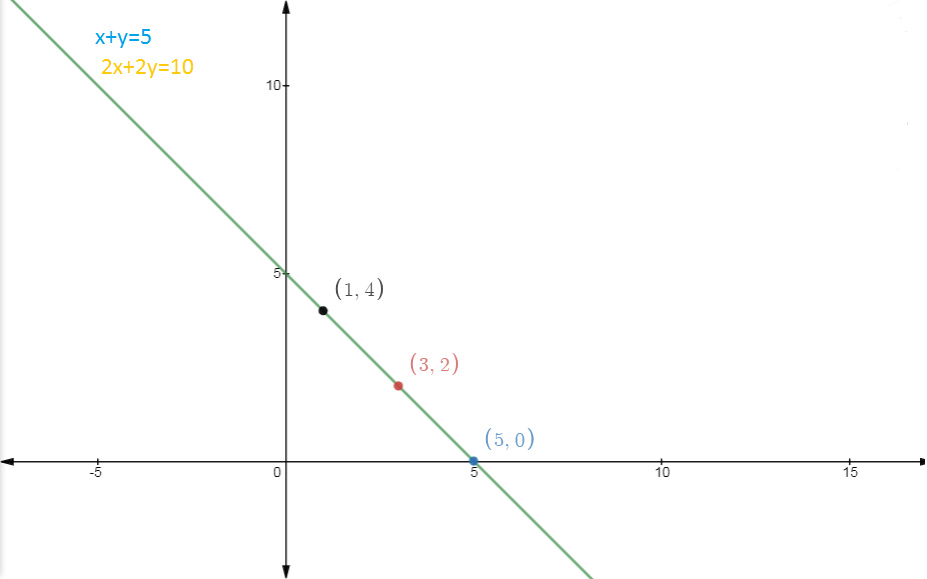
Answer:
Given Equations,
$\\x - y = 8$ and $3x - 3y = 16$
Comparing these equations with $a_1x+b_1y+c_1=0\:and\:a_2x+b_2y+c_2=0$ , we get
$\\\frac{a_1}{a_2}=\frac{1}{3},\\\:\frac{b_1}{b_2}=\frac{-1}{-3}=\frac{1}{3}\:and\\\:\frac{c_1}{c_2}=\frac{8}{16}=\frac{1}{2}$
It is observed that:
$\frac{a_1}{a_2}=\frac{b_1}{b_2}\neq\frac{c_1}{c_2}$
It means the given equations have no solution, and thus the pair of linear equations is inconsistent.
Answer:
Given Equations,
$\\2x + y - 6 =0$ and $4x - 2 y - 4 = 0$
Comparing these equations with $a_1x+b_1y+c_1=0\:and\:a_2x+b_2y+c_2=0$ , we get
$\\\frac{a_1}{a_2}=\frac{2}{4}=\frac{1}{2},\\\:\frac{b_1}{b_2}=\frac{1}{-2}=-\frac{1}{2}\:and\\\:\frac{c_1}{c_2}=\frac{-6}{-4}=\frac{3}{2}$
It is observed that;
$\frac{a_1}{a_2}\neq\frac{b_1}{b_2}$
It means the given equations have exactly one solution, and thus the pair of linear equations is consistent.
The points(x, y) satisfying the equation $\\2x + y - 6 =0$ are,
|
X |
0 |
2 |
3 |
|
Y |
6 |
2 |
0 |
And The points(x,y) satisfying the equation $\\4x - 2y - 4 = 0$ are,
|
X |
0 |
1 |
2 |
|
Y |
-2 |
0 |
2 |
GRAPH:
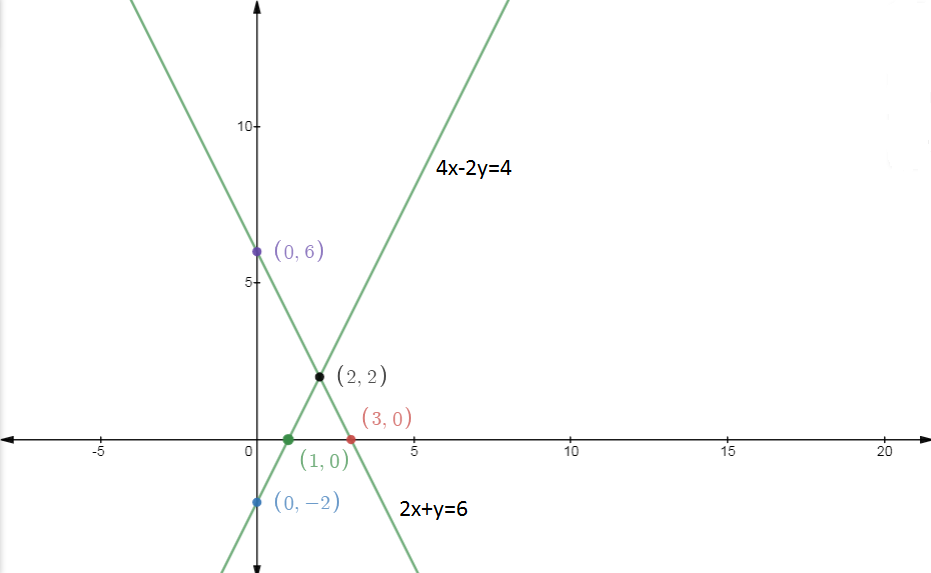
As we can see, both lines intersect at point (2,2) and hence the solution of both equations is x = 2 and y = 2.
Answer:
Given Equations,
$\\2x - 2y - 2 =0, \qquad\\ 4x - 4y -5 = 0$
Comparing these equations with $a_1x+b_1y+c_1=0\:and\:a_2x+b_2y+c_2=0$ , we get
$\\\frac{a_1}{a_2}=\frac{2}{4}=\frac{1}{2},\\\:\frac{b_1}{b_2}=\frac{-2}{-4}=\frac{1}{2}\:and\\\:\frac{c_1}{c_2}=\frac{-2}{-5}=\frac{2}{5}$
It is observed that;
$\frac{a_1}{a_2}=\frac{b_1}{b_2}\neq\frac{c_1}{c_2}$
It means the given equations have no solution, and thus the pair of linear equations is inconsistent.
Answer:
Let $ l$ be the length of the rectangular garden and $b$ be the width.
Now, according to the question, the length is 4 m more than its width, so we can write it as $l=b+4$
Or, $l-b=4....(1)$
Also given Half Parameter of the rectangle = 36 it means $l+b=36....(2)$
Now, as we have two equations, add both equations, and we get,
$l+b+l-b=4+36$
$\Rightarrow 2l=40$
$\Rightarrow l=20$
We get the value of $l$, which is 20m
Now, putting this in equation (1), we get;
$\Rightarrow 20-b=4$
$\Rightarrow b=20-4$
$\Rightarrow b=16$
Hence, the Length and width of the rectangle are 20m and 16m, respectively.
Answer:
Given the equation,
$2x + 3y -8 =0$
We know that the condition for the intersection of lines for the equations in the form $ a_1x+b_1y+c_1=0$ and $ a_2x+b_2y+c_2=0$ is,
$\frac{a_1}{a_2}\neq\frac{b_1}{b_2}$
So any line with this condition can be $4x+3y-16=0$
Proof,
$\frac{a_1}{a_2}=\frac{2}{4}=\frac{1}{2}$
$\frac{b_1}{b_2}=\frac{3}{3}=1$
Hence, $\frac{1}{2}\neq1$ it means $\frac{a_1}{a_2}\neq\frac{b_1}{b_2}$
Therefore, the pair of lines has a unique solution, thus forming intersecting lines.
Answer:
Given the equation,
$2x + 3y -8 =0$
As we know, the condition for the parallel lines for the equations in the form $ a_1x+b_1y+c_1=0$ and $ a_2x+b_2y+c_2=0$ is,
$\frac{a_1}{a_2}=\frac{b_1}{b_2}\neq\frac{c_1}{c_2}$
So any line with this condition can be $4x+6y-8=0$
Proof,
$\frac{a_1}{a_2}=\frac{2}{4}=\frac{1}{2}$
$\frac{b_1}{b_2}=\frac{3}{6}=\frac{1}{2}$
$\frac{c_1}{c_2}=\frac{-8}{-8}=1$
Hence, $\frac{1}{2}=\frac{1}{2}\neq1$ it means $\frac{a_1}{a_2}=\frac{b_1}{b_2}\neq\frac{c_1}{c_2}$
Therefore, the pair of lines has no solutions; thus, the lines are parallel.
Answer:
Given the equation,
$2x + 3y -8 =0$
As we know, the condition for the coincidence of the lines for the equations in the form $ a_1x+b_1y+c_1=0$ and $ a_2x+b_2y+c_2=0$ is,
$\frac{a_1}{a_2}=\frac{b_1}{b_2}=\frac{c_1}{c_2}$
So any line with this condition can be $4x+6y-16=0$
Proof,
$\frac{a_1}{a_2}=\frac{2}{4}=\frac{1}{2}$
$\frac{b_1}{b_2}=\frac{3}{6}=\frac{1}{2}$
$\frac{c_1}{c_2}=\frac{-8}{-16}=\frac{1}{2}$
Hence, $\frac{1}{2}=\frac{1}{2}=\frac{1}{2}$ it means $\frac{a_1}{a_2}=\frac{b_1}{b_2}=\frac{c_1}{c_2}$
Therefore, the pair of lines has infinitely many solutions; thus, the lines are coincident.
Answer:
Given two equations,
$x - y + 1=0.........(1)$
And
$3x +2 y - 12=0.........(2)$
The points (x,y) satisfying (1) are
|
X |
0 |
3 |
6 |
|
Y |
1 |
4 |
7 |
And The points(x,y) satisfying (2) are,
|
X |
0 |
2 |
4 |
|
Y |
6 |
3 |
0 |
GRAPH:
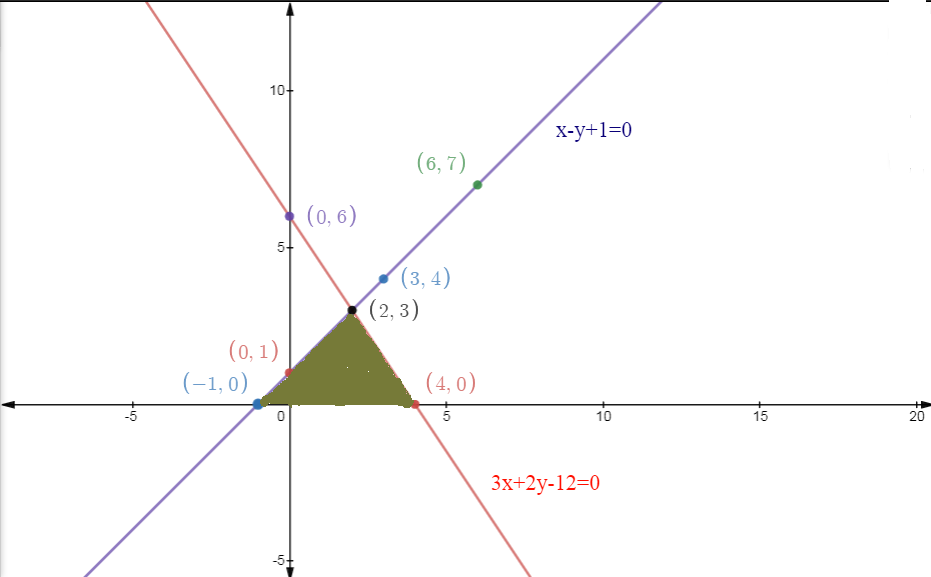
As we can see from the graph that both lines intersect at the point (2,3), And the vertices of the Triangle are ( -1,0), (2,3) and (4,0). The area of the triangle is shaded with a green color.
| Pair of Linear Equations in Two Variables Class 10 Question Answers Exercise: 3.2 Total Questions: 3 Page number: 33-34 |
Q1(i): Solve the following pair of linear equations by the substitution method.
$x+y=14$
$x−y=4$
Answer:
Given two equations,
$x+y=14$.......(1)
$x−y=4$........(2)
Now, from (1), we have
$y=14−x$........(3)
Substituting this in (2), we get
$x−(14−x)=4$
$\Rightarrow x−14+x=4$
$\Rightarrow 2x=4+14=18$
$\Rightarrow x=9$
Substituting this value of x in (3)
$\Rightarrow y=14−x=14−9=5$
Hence, the solution of the given equations is x = 9 and y = 5.
Q1(ii): Solve the following pair of linear equations by the substitution method
$s−t=3$
$\frac{s}{3}+\frac{t}{2}=6$
Answer:
Given two equations,
$s−t=3$..........(1)
$\frac{s}{3}+\frac{t}{2}=6$....... (2)
Now, from (1), we have
$s=t+3$........(3)
Substituting this in (2), we get
$\frac{t+3}{3}+\frac{t}{2}=6$
$\Rightarrow 2t+6+3t=36$
$\Rightarrow 5t+6=36$
$\Rightarrow 5t=30$
$\Rightarrow t=6$
Substituting this value of t in (3)
$\Rightarrow s=t+3=6+3=9$
Hence, the solution of the given equations is s = 9 and t = 6.
Q1(iii): Solve the following pair of linear equations by the substitution method.
$3x−y=39$
$9x−3y=9$
Answer:
Given two equations,
$3x−y=3$......(1)
$9x−3y=9$.....(2)
Now, from (1), we have
$y=3x−3$........(3)
Substituting this in (2), we get
$9x−3(3x−3)=9$
$\Rightarrow 9x−9x+9=9$
$\Rightarrow 9=9$
This is always true, and hence this pair of equations has infinite solutions.
As we have
$y=3x−3$,
One of many possible solutions is x = 1, and y = 0.
Q1(iv): Solve the following pair of linear equations by the substitution method.
$0.2x+0.3y=1.3$
$0.4x+0.5y=2.3$
Answer:
Given two equations,
$0.2x+0.3y=1.3$
$0.4x+0.5y=2.3$
Now, from (1), we have
$y=\frac{1.3−0.2x}{0.3}$........(3)
Substituting this in (2), we get
$0.4x+0.5\frac{1.3−0.2x}{0.3}=2.3$
$\Rightarrow 0.12x+0.65−0.1x=0.69$
$\Rightarrow 0.02x=0.69−0.65=0.04$
$\Rightarrow x=2$
Substituting this value of x in (3)
$\Rightarrow y=\frac{1.3−0.2x}{0.3} =\frac{1.3−0.2 × 2}{0.3} =3$
Hence, the solution of the given equations is
x = 2 and y = 3.
Q1(v): Solve the following pair of linear equations by the substitution method.
$\sqrt 2x+ \sqrt 3y=0$
$\sqrt 3x−\sqrt 8y=0$
Answer:
Given two equations,
$\sqrt 2x+ \sqrt 3y=0$
$\sqrt 3x−\sqrt 8y=0$
Now, from (1), we have
$x=\frac{−\sqrt 3y}{\sqrt 2}$........(3)
Substituting this in (2), we get
$\sqrt 3 (\frac{−\sqrt 3y}{\sqrt 2}) - \sqrt 8y=0$
$\Rightarrow \frac{−\sqrt 3y}{\sqrt 2} - 2\sqrt 2y = 0$
$\Rightarrow y(\frac{−\sqrt 3}{\sqrt 2} - 2\sqrt 2) = 0$
$\Rightarrow y=0$
Substituting this value of y in (3)
$\Rightarrow x = 0$
Hence, the solution of the given equations is,
x = 0, and y = 0 .
Q1(vi): Solve the following pair of linear equations by the substitution method.
$\frac{3x}{2}−\frac{5y}{3} =−2$
$\frac{x}{3}+\frac{y}{2}=\frac{13}{6}$
Answer:
Given,
$\frac{3x}{2}−\frac{5y}{3} =−2$ ....... (1)
$\frac{x}{3}+\frac{y}{2}=\frac{13}{6}$ ........ (2)
From (1) we have,
$x=\frac{(-12 + 10y)}{9}$........(3)
Putting this in (2), we get,
$\frac{\frac{(-12 + 10y)}{9}}{3}+ \frac{y}{2} = \frac{13}{6}$
$\frac{(-12 + 10y)}{27}+ \frac{y}{2} = \frac{13}{6}$
$\frac{(-24 + 20y + 27y)}{54} = \frac{13}{6}$
$47y=141$
$y=3$
Putting this value in (3), we get,
$x=\frac{(-12 + 10× 3)}{9}$
$x =2$
Hence, x = 2 and y = 3.
Q2: Solve 2x + 3y = 11 and 2x − 4y = −24 and hence find the value of ‘m’ for which y = mx + 3.
Answer:
Given two equations,
$2x+3y=11$......(1)
$2x−4y=−24$.......(2)
Now, from (1), we have
$y=\frac{11−2x}{3}$........(3)
Substituting this in (2), we get
$2x−4(\frac{11−2x}{3})=−24$
$\Rightarrow 6x−44+8x=−72$
$\Rightarrow 14x=44−72$
$\Rightarrow 14x=−28$
$\Rightarrow x=−2$
Substituting this value of x in (3)
$\Rightarrow y=\frac{11−2x}{3}=\frac{11−2×(−2)}{3}=\frac{15}{3}=5$
Hence, the solution of the given equations is,
x = −2, and y = 5.
Now,
As it satisfies $y=mx+3$,
$\Rightarrow 5=m(−2)+3$
$\Rightarrow 2m=3−5$
$\Rightarrow 2m=−2$
$\Rightarrow m=−1$
Hence, the value of m is -1.
The difference between the two numbers is 26, and one number is three times the other. Find them.
Answer:
Let two numbers be x and y, and the bigger number is y.
Now, according to the question,
$y−x=26$......(1)
And
$y=3x$......(2)
Now, substituting the value of y from (2) in (1), we get,
$3x−x=26$
$\Rightarrow 2x=26$
$\Rightarrow x=13$
Substituting this in (2)
$\Rightarrow y=3x=3(13)=39$
Hence, the two numbers are 13 and 39.
The larger of the two supplementary angles exceeds the smaller by 18 degrees. Find them.
Answer:
Let the larger angle be x and the smaller angle be y
Now, as we know, the sum of supplementary angles is 180. so,
$x+y=180°$.......(1)
Also given in the question,
$x−y=18°$.......(2)
Now, from (2) we have,
$y=x−18°$.......(3)
Substituting this value in (1)
$x+x−18°=180°$
$\Rightarrow 2x=180°+18°$
$\Rightarrow 2x=198°$
$\Rightarrow x=99°$
Now, substituting this value of x in (3), we get
$\Rightarrow y=x−18°=99°−18°=81°$
Hence, the two supplementary angles are
$99°$ and $81°$.
Q3: Form the pair of linear equations for the following problems and find their solution by the substitution method.
(iii) The coach of a cricket team buys 7 bats and 6 balls for Rs 3800. Later, she buys 3 bats and 5 balls for Rs 1750. Find the cost of each bat and each ball.
Answer:
Let the cost of 1 bat be x and the cost of 1 ball be y.
Now, according to the question,
$7x+6y=3800$......(1)
$3x+5y=1750$......(2)
Now, from (1) we have
$y=\frac{(3800−7x)}{6}$........(3)
Substituting this value of y in (2)
$3x+5\frac{(3800−7x)}{6}=1750$
$\Rightarrow 18x+19000−35x=1750×6$
$\Rightarrow −17x=10500−19000$
$\Rightarrow −17x=−8500$
$\Rightarrow x=\frac{8500}{17}$
$\Rightarrow x=500$
Now, Substituting this value of x in (3)
$y=\frac{(3800−7x)}{6}$
$y =\frac{3800−7×500}{6}$
$y =\frac{3800−3500}{6}=50$
Hence, the cost of one bat is 500 Rs., and the cost of one ball is 50 Rs.
Answer:
Let the fixed charge be x and the per km charge be y.
Now, according to the question
$x+10y=105$.......(1)
And,
$x+15y=155$.......(2)
Now, from (1) we have,
$x=105−10y$........(3)
Substituting this value of x in (2), we have
$105−10y+15y=155$
$\Rightarrow 5y=155−105$
$\Rightarrow 5y=50$
$\Rightarrow y=10$
Now, substituting this value in (3)
$x=105−10y$
$=105−10(10)$
$=105−100=5$
Hence, the fixed charge is 5 Rs and the per km charge is 10 Rs.
Now, Fair for 25 km :
$\Rightarrow x+25y=5+25(10) $
$=5+250=255$
Hence, the fare for 25 km is 255 Rs.
Answer:
Let the numerator of the fraction be x, and the denominator of the fraction be y
Now, according to the question,
$\frac{x+2}{y+2}=\frac{9}{11}$
$\Rightarrow 11(x+2)=9(y+2)$
$\Rightarrow 11x+22=9y+18$
$\Rightarrow 11x−9y=−4$.........(1)
Also,
$\frac{x+3}{y+3}=\frac{5}{6}$
$\Rightarrow 6(x+3)=5(y+3)$
$\Rightarrow 6x+18=5y+15$
$\Rightarrow 6x−5y=−3$...........(2)
Now, from (1) we have
$y=\frac{11x+4}{9}$.............(3)
Substituting this value of y in (2)
$6x−5(\frac{11x+4}{9})=−3$
$\Rightarrow 54x−55x−20=−27$
$\Rightarrow −x=20−27$
$\Rightarrow x=7$
Substituting this value of x in (3)
$y={11x+4}{9}$
$=\frac{11(7)+4}{9}=\frac{81}{9}=9$
Hence, the required fraction is
$x =\frac{7}{9}$
Answer:
Let x be the age of Jacob and y be the age of Jacob's son.
Now, according to the question
$x+5=3(y+5)$
$\Rightarrow x+5=3y+15$
$\Rightarrow x−3y=10$........(1)
Also,
$x−5=7(y−5)$
$\Rightarrow x−5=7y−35$
$\Rightarrow x−7y=−30$.........(2)
Now,
From (1) we have,
$x=10+3y$...........(3)
Substituting this value of x in (2)
$10+3y−7y=−30$
$\Rightarrow −4y=−30−10$
$\Rightarrow 4y=40$
$\Rightarrow y=10$
Substituting this value of y in (3),
$x=10+3y=10+3(10)=10+30=40$
Hence, the present age of Jacob is 40 years, and the present age of Jacob's son is 10 years.
| Pair of Linear Equations in Two Variables Class 10 Question Answers Exercise: 3.3 Total Questions: 2 Page number: 36-37 |
Q1(i): Solve the following pair of linear equations by the elimination method and the substitution method :
$x + y =5 \ \textup{and} \ 2x - 3y = 4$
Answer:
Elimination Method:
Given, equations
$\\x + y =5............(1) \ \textup{and} \\ \ 2x - 3y = 4........(2)$
Now, multiplying (1) by 3, we get
$\\3x +3 y =15............(3)$
Now, adding (2) and (3), we get
$\\2x-3y+3x +3 y =4+15$
$\Rightarrow 5x=19$
$\Rightarrow x=\frac{19}{5}$
Substituting this value in (1), we get
$\frac{19}{5}+y=5$
$\Rightarrow y=5-\frac{19}{5}$
$\Rightarrow y=\frac{6}{5}$
Hence,
$x=\frac{19}{5}\:and\:y=\frac{6}{5}$
Substitution method :
Given, equations
$\\x + y =5............(1) \ \textup{and} \\ \ 2x - 3y = 4........(2)$
Now, from (1) we have,
$y=5-x.......(3)$
Substituting this value in (2)
$2x-3(5-x)=4$
$\Rightarrow 2x-15+3x=4$
$\Rightarrow 5x=19$
$\Rightarrow x=\frac{19}{5}$
Substituting this value of x in (3)
$\Rightarrow y=5-x=5-\frac{19}{5}=\frac{6}{5}$
Hence,
$x=\frac{19}{5}\:and\:y=\frac{6}{5}$
Q1(ii): Solve the following pair of linear equations by the elimination method and the substitution method :
$3x + 4 y = 10 \ \textup{and} \ 2x - 2y = 2$
Answer:
Elimination Method:
Given, equations
$\\3x + 4 y = 10............(1) \ \textup{and}\\ \ 2x - 2y = 2..............(2)$
Now, multiplying (2) by 2, we get
$\\4x -4 y =4............(3)$
Now, adding (1) and (3), we get
$\\3x+4y+4x -4 y =10+4$
$\Rightarrow 7x=14$
$\Rightarrow x=2$
Putting this value in (2), we get
$2(2)-2y=2$
$\Rightarrow 2y=2$
$\Rightarrow y=1$
Hence,
$x=2\:and\:y=1$
Substitution method :
Given, equations
$\\3x + 4 y = 10............(1) \ \textup{and}\\ \ 2x - 2y = 2..............(2)$
Now, from (2) we have,
$y=\frac{2x-2}{2}=x-1.......(3)$
Substituting this value in (1)
$3x+4(x-1)=10$
$\Rightarrow 3x+4x-4=10$
$\Rightarrow 7x=14$
$\Rightarrow x=2$
Substituting this value of x in (3)
$\Rightarrow y=x-1=2-1=1$
Hence, $x=2\:and\:y=1$
Answer:
Elimination Method:
Given, equations
$\\3x - 5y -4 = 0..........(1)\ \textup{and}\ \\9x = 2y + 7$
$\\\Rightarrow 9x - 2y -7=0........(2)$
Now, multiplying (1) by 3, we get
$\\9x -15 y -12=0............(3)$
Now, subtracting (3) from (2), we get
$9x-2y-7-9x+15y+12=0$
$\Rightarrow 13y+5=0$
$\Rightarrow y=\frac{-5}{13}$
Putting this value in (1), we get
$3x-5(\frac{-5}{13})-4=0$
$\Rightarrow 3x=4-\frac{25}{13}$
$\Rightarrow 3x=\frac{27}{13}$
$\Rightarrow x=\frac{9}{13}$
Hence,
$x=\frac{9}{13}\:and\:y=-\frac{5}{13}$
Substitution method :
Given, equations
$\\3x - 5y -4 = 0..........(1)\ \textup{and}\ \\9x = 2y + 7$
$\\\Rightarrow 9x - 2y -7=0........(2)$
Now, from (2) we have,
$y=\frac{9x-7}{2}.......(3)$
Substituting this value in (1)
$3x-5\left(\frac{9x-7}{2} \right )-4=0$
$\Rightarrow 6x-45x+35-8=0$
$\Rightarrow -39x+27=0$
$\Rightarrow x=\frac{27}{39}=\frac{9}{13}$
Substituting this value of x in (3)
$\Rightarrow y=\frac{9(\frac{9}{13})-7}{2}=\frac{\frac{81}{13}-7}{2}=\frac{-5}{13}$
Hence, $x=\frac{9}{13}\:and\:y=-\frac{5}{13}$
Answer:
Elimination Method:
Given, equations
$\\\frac{x}{2} + \frac{2y}{3} = -1........(1)\ \textup{and} \ \\ \\x - \frac{y}{3} = 3............(2)$
Now, multiplying (2) by 2, we get
$\\2x - \frac{2y}{3} =6............(3)$
Now, adding (1) and (3), we get
$\\\frac{x}{2}+\frac{2y}{3}+2x-\frac{2y}{3}=-1+6$
$\Rightarrow \frac{5x}{2}=5$
$\Rightarrow x=2$
Putting this value in (2), we get
$2-\frac{y}{3}=3$
$\Rightarrow \frac{y}{3}=-1$
$\Rightarrow y=-3$
Hence,
$x=2\:and\:y=-3$
Substitution method :
Given, equations
$\\\frac{x}{2} + \frac{2y}{3} = -1........(1)\ \textup{and} \ \\ \\x - \frac{y}{3} = 3............(2)$
Now, from (2) we have,
$y=3(x-3)......(3)$
Substituting this value in (1)
$\frac{x}{2}+\frac{2(3(x-3))}{3}=-1$
$\Rightarrow \frac{x}{2}+2x-6=-1$
$\Rightarrow \frac{5x}{2}=5$
$\Rightarrow x=2$
Substituting this value of x in (3)
$\Rightarrow y=3(x-3)=3(2-1)=-3$
Hence, $x=2\:and\:y=-3$
Answer:
Let the numerator of the fraction be x, and the denominator is y,
Now, according to the question,
$\frac{x+1}{y-1}=1$
$\Rightarrow x+1=y-1$
$\Rightarrow x-y=-2.........(1)$
Also,
$\frac{x}{y+1}=\frac{1}{2}$
$\Rightarrow 2x=y+1$
$\Rightarrow 2x-y=1..........(2)$
Now, subtracting (1) from (2), we get
$x=3$
Putting this value in (1)
$3-y=-2$
$\Rightarrow y=5$
Hence, $x=3\:and\:y=5$
And the fraction is: $\frac{3}{5}$
Answer:
Let the age of Nuri be x and the age of Sonu be y.
Now, according to the question
$x-5=3(y-5)$
$\Rightarrow x-5=3y-15$
$\Rightarrow x-3y=-10.........(1)$
Also,
$x+10=2 (y+10)$
$\Rightarrow x+10=2y+20$
$\Rightarrow x-2y=10........(2)$
Now, subtracting (1) from (2), we get
$y=20$
Putting this value in (2)
$x-2(20)=10$
$\Rightarrow x=50$
Hence, the age of Nuri is 50 and the age of Nuri is 20.
Answer:
Let the unit digit of the number be x and the 10's digit be y.
Now, according to the question,
$x+y=9.......(1)$
Also
$9(10y+x)=2(10x+y)$
$\Rightarrow 90y+9x=20x+2y$
$\Rightarrow 88y-11x=0$
$\Rightarrow 8y-x=0.........(2)$
Now adding (1) and (2), we get,
$\Rightarrow 9y=9$
$\Rightarrow y=1$
Now putting this value in (1)
$x+1=9$
$\Rightarrow x=8$
Hence, the number is 18.
Answer:
Let the number of Rs 50 notes be x and the number of Rs 100 notes be y.
Now, according to the question,
$x+y=25..........(1)$
And
$50x+100y=2000$
$\Rightarrow x+2y=40.............(2)$
Now, subtracting (1) from (2), we get
$y=15$
Putting this value in (1).
$x+15=25$
$\Rightarrow x=10$
Hence, Meena received 10, 50 Rs notes and 15, 100 Rs notes.
Answer:
Let the fixed charge be x, and per day charge is y.
Now, according to the question,
$x+4y=27...........(1)$
And
$x+2y=21...........(2)$
Now, Subtracting (2) from (1). We get,
$4y-2y=27-21$
$\Rightarrow 2y=6$
$\Rightarrow y=3$
Putting this in (1)
$x+4(3)=27$
$\Rightarrow x=27-12=15$
Hence, the fixed charge is 15 Rs and the per-day charge is 3 Rs.
Pair of Linear Equations in Two Variables Class 10 NCERT Solutions: Exercise-wise
Exercise-wise NCERT Solutions of Pair of Linear Equations in Two Variables Class 10 Maths Chapter 3 are provided in the links below.
NCERT Pair of Linear Equations in Two Variables Class 10 Solutions: Notes
Linear Equations
Linear equations are polynomials of degree one. Eg: 3x=7,2x+6y=10
Types of Linear Equations
|
S. No. |
Types of Linear Equations |
General form |
Description |
Solutions |
|
1. |
Linear Equation in one Variable |
ax + b = 0 |
Where a ≠ 0 and a & b are real numbers |
One Solution |
|
2. |
Linear Equation in Two Variables |
ax + by + c = 0 |
Where a ≠ 0 & b ≠ 0 and a, b & c are real numbers |
Infinite Solutions possible |
|
3. |
Linear Equation in Three Variables |
ax + by + cz + d = 0 |
Where a ≠ 0, b ≠ 0, c ≠ 0 and a, b, c, d are real numbers |
Infinite Solutions possible |
Simultaneous System of Linear Equations:
The simultaneous system of linear equations in two variables is in the format,
a1x + b1y + c1 = 0
a2x + b2y + c2 = 0
The simultaneous system of linear equations can be solved using two methods,
1. Graphical Method
2. Algebraic Method
Graphical Method
Two lines represent the graph of a pair of linear equations in two variables.
(i) If the lines intersect at a point, then that point gives the unique solution of the two equations. In this case, the pair of equations is consistent.
(ii) If the lines coincide, then there are infinitely many solutions, each point on the line being a solution. In this case, the pair of equations is dependent (consistent).
(iii) If the lines are parallel, then the pair of equations has no solution. In this case, the pair of equations is inconsistent.

Algebraic Method:
The pair of linear equations can be solved using the algebraic method in two other methods, namely,
1. Substitution Method
2. Elimination Method
Substitution Method
In the substitution method, one of the linear equations is converted to an equation based on any one of the variables. Eg. The equation x−y=1 can be converted into x=y+1. Now, this value of x is substituted in the second linear equation, which makes the equation a linear equation of one variable, which is much easier to solve.
Elimination Method
In the elimination method, the given system of equations is manipulated to eliminate one of the variables by adding or subtracting the equations.
For example,
Consider the system of equations:
$2x+3y=8$
$ 4x−3y=10$
To eliminate y, we add both equations:
$(2x+3y)+(4x−3y)=8+10$
$6x=18$
$x=3$
Now, substituting $x=3$ in the first equation:
$
\begin{aligned}
& 2(3)+3 y=8 \\
& \Rightarrow 6+3 y=8 \\
& \Rightarrow 3 y=2 \\
& \Rightarrow y=\frac{2}{3}
\end{aligned}
$
Thus, the solution is $\left(3, \frac{2}{3}\right)$.
Pair of Linear Equations in Two Variables Class 10 Chapter 3: Topics
Topics you will learn in NCERT Class 10 Maths Chapter 3 Pair of Linear Equations in Two Variables include:
- Introduction
- Graphical Method of Solution of a Pair of Linear Equations
- Algebraic Methods of Solving a Pair of Linear Equations
- Substitution Method
- Elimination Method
Why are Class 10 Maths Chapter 3 Pair of Linear Equations in Two Variables Question Answers Important?
Linear equations are used to solve problems where two things are related by straight-line equations. This chapter teaches us different methods to solve such equations easily, both graphically and algebraically. These Class 10 Maths Chapter 3 Pair of Linear Equations in Two Variables question answers help students practise these methods step by step. Here are some more points on why these question answers are important:
- These solutions help us learn different ways to solve pairs of equations using the substitution and elimination methods.
- These question answers make it easier to understand how two lines can intersect, be parallel, or coincide on a graph.
- These Class 10 Maths Chapter 3 Pair of Linear Equations in Two Variables question answers prepare us for higher classes, where you’ll study systems of equations and coordinate geometry in detail.
- They also help in solving real-life problems where two quantities are connected by equations.
NCERT Solutions for Class 10 Maths: Chapter Wise
Access all NCERT Class 10 Maths solutions from one place using the links below.
Also, read,
- NCERT Exemplar Class 10 Maths Solutions Chapter 3 Pair of Linear Equations in Two Variables
- NCERT Notes Class 10 Maths Chapter 3 Pair of Linear Equations in Two Variables
NCERT Exemplar Solutions Subject-wise
Here are the links to NCERT exemplar solutions, which will help students in their studies.
NCERT Books and NCERT Syllabus
Students can use the following links to check the latest NCERT syllabus and read some reference books.
Frequently Asked Questions (FAQs)
A linear equation in two variables is an equation that can be written in the form ax + by + c = 0, where a, b, and c are real numbers, and a and b are not zero.
In this method, one variable is expressed in terms of the other from one equation and substituted into the second equation to find the values of both variables.
Here, one variable is eliminated by adding or subtracting the two equations after multiplying them (if necessary) to make the coefficients of one variable equal.
In the substitution method, one of the linear equations is converted to an equation based on any one of the variables. Example: The equation x - y = 1 can be converted into x = y + 1.
Now, this value of x is substituted in the second linear equation, which makes the equation a linear equation of one variable, which is much easier to solve.
Yes, many educational platforms, such as Careers360, offer free downloadable PDFs of NCERT Pair of Linear Equations in Two Variables Class 10 Solutions. Students can find the free downloadable PDF in this article itself.
The graph of a pair of linear equations in two variables is represented by two lines. Graph the linear equations and find the intersection points. The solution of the linear equations depends on the intersection points.
(i) If the lines intersect at a point, then that point gives the unique solution of the two equations.
(ii) If the lines coincide, then there are infinitely many solutions — each point on the line being a solution.
(iii) If the lines are parallel, then the pair of equations has no solution.
The chapter teaches four important methods:
Graphical Method
Substitution Method
Elimination Method
Cross-Multiplication Method
(i) If the lines intersect at a point, then that point gives the unique solution of the two equations. In this case, the pair of equations is consistent.
(ii) If the lines coincide, then there are infinitely many solutions — each point on the line being a solution. In this case, the pair of equations is dependent (consistent).
(iii) If the lines are parallel, then the pair of equations has no solution. In this case, the pair of equations is inconsistent.
Questions related to CBSE Class 10th
On Question asked by student community
The CBSE Sahodaya Question Papers for Class 10 (2025-26) are not released centrally by the board as a single PDF.
Here is the essential information you need:
-
Local Release: The papers are designed and released by the individual Sahodaya School Clusters (groups of CBSE schools) just before or during the pre-board exam dates (typically held in December and January). Therefore, you must check your local cluster's portal or directly with your school administration.
-
Best Practice: The official model papers, based on the full 2026 syllabus, are the most reliable tool for practice. These accurately reflect the structure, format, and competency-based questions used in the Sahodaya exams.
You can download the latest CBSE Class 10 Model Papers to simulate the Sahodaya tests here: https://school.careers360.com/articles/sahodaya-question-paper-2025 . Focus on that pattern
Hi! If you’re looking for the Class 11 English half yearly question paper for 2025-26 (CBSE board), you’ll find the right resource once you check the link provided from Careers360. Solving previous or sample papers is a smart way to prepare, as it helps you understand the question types, marking scheme, and important topics. This practice will boost your confidence and help you manage your time well in the actual exam.
https://school.careers360.com/boards/cbse/cbse-class-11-half-yearly-sample-papers-2025-26
Hi dear candidate,
Could you please specify us the board of education for which you need the half yearly question papers of class X so that we can help you further.
Below are few links which may help you and it has all the subjects with English as well:
CBSE Class 10 Half Yearly Exam Question Paper 2025-26 with Answer Key & Analysis
ICSE Class 10 Half Yearly Sample Papers 2025-26 PDF (All Subjects)
BEST REGARDS
Hi dear candidate,
Can you please specify the board of education or state for which you need to know the exam pattern and syllabus so that we can guide you accordingly.
Since, most of the boards uses NCERT as base syllabus, you can refer to the link below:
NCERT Syllabus for Class 10 – All Subjects PDF Download 2025-26
Exam pattern:
CBSE 10th New Exam Pattern 2026- Marking Scheme, Subject-Wise Exam Pattern
BEST REGARDS
The CBSE Class 10th Board Exams for the 2026 session will follow the revised curriculum, emphasizing competency-based questions.
-
Conducting Body: Central Board of Secondary Education (CBSE).
-
Exam Period: The main theory exams are typically held between February and April 2026.
-
Grading: Based on marks in five main subjects plus internal assessment marks (often 20 marks per subject) provided by the school.
-
Passing Criteria: You must achieve at least 33% overall in each subject (theory + practical/internal assessment combined) to be declared pass.
Key Preparation Strategy
The most crucial element of your preparation is understanding the exam structure:
-
Syllabus: Strictly adhere to the rationalized syllabus released by CBSE for the 2025-26 academic year.
-
Practice: Your primary resource should be the latest sample papers and previous year question papers. These accurately reflect the format and types of competency questions being asked.
For the most comprehensive and official announcements, including the detailed time table and access to crucial practice materials, always check the official board updates, as tracked by Careers360: https://school.careers360.com/exams/cbse-class-10th .
Applications for Admissions are open.
As per latest syllabus. Physics formulas, equations, & laws of class 11 & 12th chapters
JEE Main Important Chemistry formulas
Get nowAs per latest syllabus. Chemistry formulas, equations, & laws of class 11 & 12th chapters
JEE Main high scoring chapters and topics
Get nowAs per latest 2024 syllabus. Study 40% syllabus and score upto 100% marks in JEE
JEE Main Important Mathematics Formulas
Get nowAs per latest syllabus. Maths formulas, equations, & theorems of class 11 & 12th chapters
